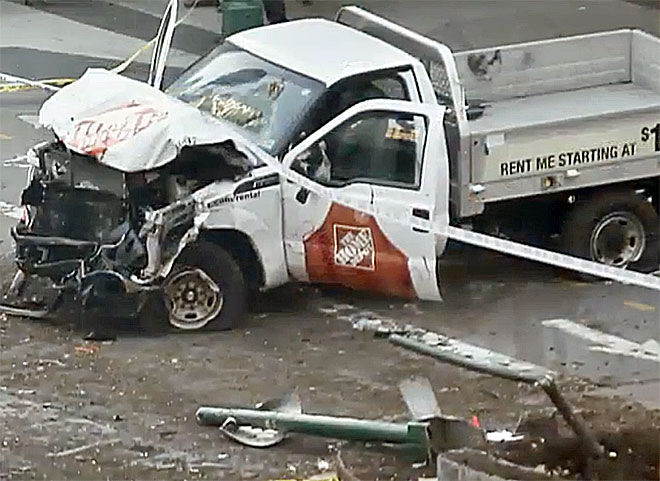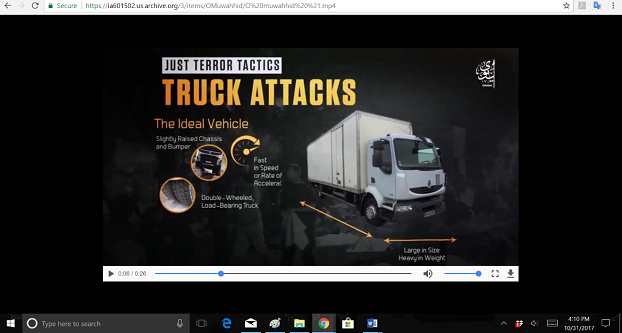
By Shimon Prokupecz, Eric Levenson, Brynn Gingras and Ray Sanchez, CNN
Authorities found a note in the truck Sayfullo Saipov allegedly used in the New York terror attack claiming he did it in the name of ISIS, a senior law enforcement official told CNN.
The note was in English, the source said.
The driver of a rental truck drove down a busy bicycle path in New York near the World Trade Center, killing eight people and injuring about a dozen others in what officials said was an “act of terror.”
(Learn More. Courtesy of Fox News and YouTube)
After crashing the truck into a school bus, the suspect exited the vehicle while displaying imitation firearms and was shot in the abdomen by a police officer, according to the NYPD.
The suspect, a 29-year-old man, is in police custody and was taken to a hospital for treatment, officials said.
He was identified by two law enforcement sources familiar with the investigation as Sayfullo Habibullaevic Saipov.
The suspect is from the central Asian nation of Uzbekistan and came to the United States in 2010, sources told CNN.
The incident is being investigated as terrorism, officials said.

Witnesses reported the suspect was yelling “Allahu Akbar,” according to four law enforcement sources.
The FBI’s Joint Terrorism Task Force is taking over the lead of the investigation.
“This was an act of terror, and a particularly cowardly act of terror,” New York Mayor Bill de Blasio said, “aimed at innocent civilians, aimed at people going about their lives who had no idea what was about to hit them.”
(New York Mayor Bill de Blasio says that the deadly attack in New York where a truck hit people on a bike path is an act of terror. Courtesy of CNN and YouTube)
Here are the latest developments in the attack:
- The suspect is out of surgery, a law enforcement source told CNN.
- Before going into surgery, law enforcement was able to talk to him, the source said.
- It is not known if he told them anything.
- A Tampa, Florida, address is connected to the suspect.
- Investigators are also looking into a possible connection to New Jersey, the sources said.
- The man rented the truck in New Jersey on Tuesday, a person briefed on the investigation told CNN.
- President Donald Trump tweeted that the incident “looks like another attack by a very sick and deranged person.”
- In a later tweet, he wrote, “My thoughts, condolences and prayers to the victims and families of the New York City terrorist attack. God and your country are with you!”
- Argentina’s Ministry of Foreign Affairs said on Twitter that Argentine citizens were killed, but did not disclose how many had died.
- A Belgian national also was a victim of the attack, Didier Reynders, Deputy Prime Minister and Foreign Affairs Minister for Belgium, said on Twitter.
- New York Gov. Andrew Cuomo directed One World Trade Center to be lit in red, white and blue in honor of freedom and democracy, his office said.
Rented Truck Used
Authorities think it is an act of terror because the driver said something moments after leaving the truck and the method of the attack were consistent with other terrorist attacks, New York Police Commissioner James P. O’Neill said.
Vehicles have been used as weapons in a number of terrorist attacks in recent years, including in deadly incidents in Nice, France, and London.
The suspect, driving in a Home Depot rental truck, hopped a curb at West Houston Street and drove south on the bike path on the west side of West Side Highway in Lower Manhattan for several blocks, officials said.
A pellet gun and a paintball gun were recovered from the scene, officials said.
A suspect drove a white truck down a heavily trafficked bike path in New York City on Thursday.
Just after the incident, news footage showed several mangled bicycles on the popular bike path as medics tended to the wounded in the background.
Six people were declared dead at the scene and two were pronounced dead at the hospital.
(Law enforcement officials told CBS News the suspect has been identified as 29-year-old Sayfullo Habibullaevic Saipov from Tampa, Florida. Courtesy of CBS Chicago and YouTube)
At lease 11 others were transported to the hospital with serious but non-life-threatening injuries, according to New York Fire Commissioner Daniel Nigro.
No other suspects are being sought, the NYPD said.
A spokesman for Home Depot confirmed one of the company’s rental trucks was part of an incident in lower Manhattan and said the company is “cooperating with authorities” in the investigation.
Witness accounts
News footage showed crowds of spectators — some capturing the scene with cellphone cameras — gathered behind police lines.
A white Home Depot truck with the front end smashed was also visible.
Eugene Duffy said he had just left work at Pier 26 and was waiting on the light to cross West Street when he heard a scream.
He thought it might have been a Halloween prank but he said the scream was bloodcurdling.
(Eugene Duffy says he saw a white truck drive the wrong way on a Manhattan bike path and two men with tire tracks across their bodies. Courtesy of CNN and YouTube)
“I look down and I see a white pickup truck a couple of more blocks down in the bike path,” he said.
“Automatically, I know something’s wrong. Then, as I go down more toward where the girl is screaming, I see two gentlemen laying there and they have tire tracks marked across their bodies. You could tell they both weren’t here.”
He continued to walk closer to the scene. Gunshots rang out. He saw cops ducking for cover.
A yellow school bus was smashed nearby. Cops descended on the area.
“I thought automatically, this area, I thought it was terrorism,” he said.
(Former NYC Police Commissioner Bill Bratton discusses the deadly truck attack in New York City that is being called an “act of terror.” Courtesy of MSNBC and YouTube)
Michael Corbin, the assistant real estate manager for District Council 37, the city’s largest public employees union, was standing outside the union’s lower Manhattan offices attending to a woman who slipped and fell on the sidewalk.
“The first responder to the event was a counterterrorism officer,” he said.
“We were attending to the victim, getting her onto a stretcher and, at that moment, we heard gunshots.”
“I recalled hearing five gunshots in quick succession and immediately the officer … left to investigate the situation from the direction we heard the noise coming from.”
Another witness, Ramon Cruz, described what he saw.
“What I saw was that the driver — he didn’t look like he was bleeding,” said Cruz.
“He was dragging his foot. He looks frustrated, panicked, confused. People are running past me, saying, ‘He’s got a gun. He’s got a gun.'”
“I didn’t see any gun.”
“It was a white pickup truck. He looked pretty bad without bleeding or anything like that.”
“I didn’t see him hit anybody. All I heard was the impact of a crash.”
Tuesday afternoon on Twitter, a user posted an image of a person lying on the ground near the scene of an incident near West & Chambers Streets in Manhattan.
Uzbekistan Ties
Authorities are sure to look at whether the suspect visited Uzbekistan since he moved to the United States seven years ago, CNN terrorism analyst Paul Cruickshank said.
“There has been a significant problem with jihadism in Uzbekistan,” he said.
According to Cruickshank there are two large jihadi groups in the country.
One of them is the Islamic Movement of Uzbekistan, which is affiliated with ISIS.
In April, an Uzbek man was arrested after a truck attack killed four people in Stockholm.
CNN’s Jessica Schneider, David Shortell, Steve Almasy, Karen Smith and Intisar Seraaj contributed to this report.
Original post http://www.cnn.com/2017/10/31/us/new-york-shots-fired/index.html
Learn More…
Vehicles as Weapons of Terror
By The Counter Extremism Project (CEP)
Executive Summary
On July 14, 2016, Tunisian-born Mohamed Lahouaiej-Bouhlel drove a 19-ton truck into a crowd celebrating Bastille Day at Nice’s Promenade des Anglais, killing 86 people and wounding more than 430 others.
ISIS claimed responsibility for the terrorist attack two days later, calling Lahouaiej-Bouhlel a “soldier of the Islamic State.”
The attack in Nice, though not the first of its kind, was the deadliest modern vehicular terrorist attack* in Europe, launching a wave of terrorist and ISIS-claimed vehicular attacks around the world.
(How events unfolded when a truck driver ploughed through crowds of people celebrating Bastille Day in Nice, France. Courtesy of The Wall Street Journal and YouTube. Posted on Jul 15, 2016)
Since the Nice attacks, CEP has documented major vehicular incidents in Vienna,* Ohio,* Berlin,* London,* Antwerp,* Stockholm,*Paris,* Barcelona,* Edmonton,* and most recently in New York on October 31, 2017.*
In that attack, an assailant drove a rented Home Depot truck onto a bicycle path along New York City’s West Side Highway for approximately 20 blocks.
Police shot and arrested the driver after he drove into a school bus. At least eight people were killed and approximately 15 are wounded.*
The Nice attack set off a wave of vehicular terrorist attacks in autumn of that year, which collectively left 12 people dead and 67 others wounded.
In September 2016, an assailant drove his car at shoppers in Vienna’s Favoriten district while shouting “Allahu Akbar,” leaving no injuries.*
In November 2016, Somali-born Abdul Razak Ali Artan carried out a car and knife attack at Ohio State University, wounding 11 people.*
In December 2016, Tunisian-born Anis Amri charged at pedestrians attending the Christmas Market in Berlin, killing 12 people and wounding 56 others in an attack claimed by ISIS.
Footage released by the ISIS-affiliated Amaq news agency showed Amri pledging allegiance to the group’s leader, Abu Bakr al-Baghdadi, vowing “we will slaughter” the “crusaders who are shelling the Muslims every day.”*
CEP has documented at least 34 vehicular terrorist attacks since 2006, collectively resulting in the deaths of at least 194 people and the injury of at least 1,049 others.
(ISIS has told followers to use vehicles and knives in attacks. At least 11 attacks have involved vehicles in the last year. Courtesy of Fox News and YouTube)
Vehicular attacks continued into 2017, leaving at least 32 people dead and more than 240 wounded.
On March 22, 2017, terrorist assailant Khalid Masood killed five people and wounded 50 more during a vehicle and stabbing attack in London.*
The following day, a similar attack was thwarted in Antwerp, Belgium.*
On April 7, another assailant carried out a suspected terrorist attack, this time in Sweden, hijacking a truck and careening into crowds of pedestrians at the Ahlens Mall in Stockholm, killing four people and wounding 15 more.*
On the evening of June 3, 2017, three assailants drove a van at high speed into crowds on the London Bridge and exited the vehicle to stab other pedestrians at the nearby Borough Market.*
(London police responded tonight to reports of a vehicle attack on London Bridge. The vehicle plowed into pedestrians, and then shortly afterwards also faced reports of stabbings at Borough Market and another incident in the Vauxhall area. Courtesy of ABC News and YouTube. Posted on Jun 3, 2017)
The attack, claimed by ISIS, left at least seven people dead and 48 others wounded, and followed a call by ISIS on May 17 to carry out terrorist attacks in the United States, United Kingdom and European Union using knives and trucks.*
On June 19, 2017, an assailant drove at a crowd of worshipers near a mosque in north London, leaving at least eight people wounded.*
Later that day, an armed assailant rammed his vehicle at a police car on the Champs-Elysees street in Paris, seriously injuring himself but leaving no other casualties.*
On August 17, 2017, a van was deliberately driven into a crowd of tourists in Las Ramblas, a tree-lined street in the center of Barcelona.
The attack, claimed by ISIS, left 16 people dead and 120 others wounded.*
On September 30, 2017, an assailant launched two vehicular terror attacks in Edmonton, Canada, collectively injuring five people.
In the first attack, the assailant used a car to ram into a police officer before exiting the car and stabbing him.
The assailant later used a truck to ram into pedestrians, injuring another four people. An ISIS flag was later found in the suspect’s vehicle.*
(Canadian authorities say two separate attacks in Edmonton are being investigated as acts of terrorism after a man struck a police officer with a car before stabbing him and later plowed a truck into pedestrians on a busy street, injuring at least four people. Courtesy of NBC News. Posted on Oct 1, 2017)
Despite the recent uptick in ISIS-claimed attacks, vehicular attacks are not a new phenomenon.
Terrorists have carried out car-ramming attacks for more than a decade, in locations ranging from North Carolina* to Jerusalem,* Tel Aviv,* Quebec,* Dijon,*Nantes,* the West Bank,* Graz,* and Xinjiang,*
The recent uptick in vehicular attacks, however, appears to have been in large part inspired by ISIS’s explicit calls to employ cars as weapons.
In May 2017, the U.S. Transportation and Security Agency (TSA) issued a warning to truck and bus companies urging companies to watch out for potential vehicular terrorist assailants and listing more than a dozen car-ramming attacks since 2014 that have collectively killed more than 170 people.*
As the TSA wrote in its memo, terrorists groups will likely continue to encourage “unsophisticated tactics such as vehicle-ramming” since these types of attacks are difficult to prevent and “could inflict mass casualties if successful.”*
Al-Qaeda, ISIS, and Hamas Call for (and Claim) Attacks
Terrorist groups like al-Qaeda, ISIS, and Hamas have long called for—and claimed responsibility for—vehicular terrorist attacks.
Al-Qaeda’s second issue of Inspire magazine, released in October 2010, contained an article calling for vehicular attacks and referring to a pickup truck as a potential “mowing machine” that can be used to “mow down the enemies of Allah.”*
Inspire editor-in-chief Yahya Ibrahim urged al-Qaeda followers to “[g]o for the most crowded location” and “pick up as much speed as you can” in order “strike as many people as possible.”*
An FBI memo released in December of that year noted the emerging danger from vehicular attacks, which may allow terrorists with “limited access to explosives or weapons” the ability to conduct an attack with “minimal prior training or experience.”*
Following the October 31, 2017, truck-ramming attack in New York City, several old images praising vehicular and other attacks reappeared on pro-ISIS channels on the encrypted messaging service Telegram. In addition, ISIS propaganda calling for vehicular attacks was accessible online the same day of the attack.
On October 16, 2017, an Internet user uploaded to the U.S. Internet Archive an ISIS video instructing how to carry out a ramming attack.
The video is a 26-second segment of the longer video, “We Will Surely Guide Them to Our Ways,” which features the self-identified American fighter Abu Hamza Al-Amriki, who encourages lone wolf attacks with knives and motor vehicles.
The video also features several short clips of U.S.-based locations, including New York City’s Times Square. The video was originally released on May 17, 2017.
In September 2014, ISIS spokesman Abu Muhammad al-Adnani issued a call to kill non-believers using any means at their disposal. “[S]ingle out the disbelieving American, Frenchman, or any of his allies,” he said.
“Smash his head with a rock, or slaughter him with a knife, or run him over with your car.”*
In November of that year, French foreign fighter Abu Salman al-Faranci appeared in a video reiterating ISIS’s call for followers—particularly in France—to carry out domestic attacks if they could not join ISIS abroad.
As Faranci said to his viewers: “Terrorize them and do not allow them to sleep due to fear and horror. There are weapons and cars available and targets ready to be hit.”*
In mid-November 2016, ISIS’s third issue of online magazine Rumiyah included an article calling for its followers to carry out vehicle attacks.
The article specified the ideal type, weight, and speed of a car needed for terror purposes, and encouraged attacks on “large outdoor conventions and celebrations, pedestrian-congested streets, outdoor markets, festivals, festivals, parades[, and] political rallies.”*
Later that month, Somali-born Abdul Razak Ali Artan carried out a car and knife attack at Ohio State University, wounding 11 people.*
(Terrorism suspected in Ohio State University attack. Courtesy of Fox News and YouTube. Posted on Nov 29, 2016)
Following the wave of vehicular terrorist attacks in 2016 and 2017, ISIS has continued to issue calls to violence and warnings of additional car-ramming attacks.
On May 17, 2017, the group released a video threatening attacks in the United Kingdom, Europe, and the United States, especially in New York, Las Vegas, and Washington, D.C. ISIS has also threatened and encouraged vehicular attacks on gay pride parades.*
In June 2017, an account operating under the name of ISIS’s Nashir agency released a renewed call for ISIS supporters to “[r]un over people by vehicles and [c]ut off their necks in any time [sic].”*
ISIS and al-Qaeda are not the only terrorist groups to urge or claim credit for vehicular terrorist attacks.
One of the first documented vehicular attacks was carried out by an unaffiliated Iranian-American, who wounded nine people at the University of North Carolina in 2006.*
As the assailant Mohammed Reza Taheri-azar told investigators, he had had carried out the attack in an effort to punish the U.S. government and “avenge the deaths or murders of Muslims around the world.”*
A slew of car-ramming attacks have also been carried out by Palestinian assailants in Israel and the West Bank.
In November of 2014, Hamas and other Palestinian terrorist groups—including the Palestinian Islamic Jihad (PIJ)—praised a wave of vehicular attacks and called for more.
One such image posted online read, “Run [them] over, son of Hebron…and son of Jerusalem. Take your car…and run over the Zionists.”*
Recent Vehicular Terrorist Attacks
Terrorists have carried out attacks using cars and trucks in a wide range of countries, including the United States, United Kingdom, France, Canada, China, Germany, Israel, and Belgium.
In some cases, assailants have used gas canisters or other explosives to supplement the potential damage from car-ramming attacks.
This type of planning could be seen in the June 2007 Islamist attack targeting Glasgow Airport in Scotland,* the May 2014 attack in China’s Xinjiang province,* and the June 2015 attack on a gas plant in southern France.*
(Terrorist Attack in Glasgow on June 30, 2007. Courtesy of MSNBC, NewsUniverse and YouTube. Posted on Aug 28, 2009)
In other cases, extremists have managed to launch deadly or harmful vehicular attacks using low-sophistication tactics like car-ramming and stabbing.
CEP has documented more than two dozen vehicular terrorist attacks since 2000.
Of these, the single deadliest attack was the July 2016 Bastille Day attack in Nice, when terrorist assailant Mohamed Lahouaiej-Bouhlel killed 86 people and wounded 434 more at Nice’s Promenade Des Anglais.*
As the TSA notes, vehicular terrorist attacks are becoming “more commonplace around the globe.”*
Indeed, terrorists are increasingly relying on low-sophistication tactics like car-ramming and stabbing to kill or injure large groups of people without easy detection or intervention by law enforcement.
These assailants often target locations where large numbers of people congregate, particularly on or around major national holidays, when civilians are likely to be outdoors shopping or celebrating.*
Although there is little that can be done to prevent the weaponization of motor vehicles, the TSA has encouraged bus and trucking companies to be vigilant about indicators—like modifications to vehicles—that may suggest a vehicular terrorist attack.
The TSA has also encouraged the use of vehicle barriers to prevent vehicles from accelerating into populated areas, protecting large crowds of people from attacks at outdoor venues like concerts, sporting events, and holiday markets.*
As CEP notes, far more can also be done by tech companies to counteract calls to violence by groups like ISIS, al-Qaeda, and Hamas.
After the March 2017 Westminster attack, YouTube was “inundated with violent ISIS recruitment videos,” according to findings by the U.K. government.
The British government noted that YouTube failed to block this slew of content, despite the videos being easily searchable and posted under usernames like “Islamic Caliphate.”*
After the June 2017 London Bridge attack, U.K. Prime Minister Theresa May called for increased regulation on the Internet, where terrorist recruitment and incitement to violence largely takes place remotely.
(Prime Minister Theresa May has said it is time to say “enough is enough” when it comes to tackling terrorism. “We cannot and must not pretend that things can continue as they are,” she said. Courtesy of BBC News and YouTube. Posted on Jun 4, 2017)
*Despite Google’s claims to have improved its takedown efforts, CEP has tracked the appearance and reappearance of major ISIS videos on YouTube (Google’s subsidiary), including those calling for vehicular terrorist attacks.
CEP’s findings raise serious questions about Google’s stated commitment to confronting terrorist recruitment using hashing technology, which prevents flagged content from being re-uploaded to a platform.
CEP has tracked the appearance and reappearance of major ISIS videos on YouTube calling for vehicular terrorist attacks.
CEP’s findings raise serious questions about the company’s stated commitment to confronting terrorist recruitment on its platform.
In many cases, assailants themselves are active on tech platforms like Google, Facebook, and WhatsApp prior to carrying out the attack.
Abdul Razak Ali Artan, perpetrator of the November 2016 Ohio State University attack, called al-Qaeda cleric Anwar al-Awlaki “our hero” in a message posted to Facebook.*
Khalid Masood, perpetrator of the March 2017 Westminster attack, sent a message on WhatsApp announcing his intention to wage jihad minutes before launching his assault.*
While it is impossible to prevent all vehicular terrorist attacks, far more can and should be done to reduce the threat.
These companies can also be more proactive and cooperative with law enforcement about the activity of lone-wolf terrorists on their platforms.
Although we cannot prevent each and every vehicular attack, efforts to prevent even a few attacks can have the foreseeably large impact of reducing widespread fear and, most importantly, saving lives.






















